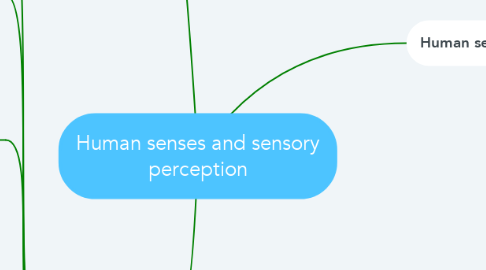
1. Threshold
1.1. the point of intensity that you can JUST detect presence/difference of the stimulus
1.2. stimuli with intensity lower than the threshold are not detectable
1.2.1. will not elicit any sensation
1.3. Absolute threshold
1.3.1. detection threshold
1.3.1.1. lowest level at which the stimuli can be detected 50% of time
1.4. Recognition threshold
1.4.1. the level at which the stimuli can be recognised
1.5. Just-noticeable difference
1.5.1. the smallest detectable difference between a starting and secondary level of a sensory stimulus
1.5.1.1. eg the minimal sugar added to make a difference/satisfy customers' needs
1.5.2. market (price VS quality)
1.6. Terminal threshold
1.6.1. the level beyond which the stimulus can no long be detected
1.6.1.1. because sensory organs are saturated, the sense reach plateau
2. psychophysics
2.1. scientific study of the relation between physical stimuli and resulting sensation and perception
2.1.1. eg relationship between propionic acid and odor strength
2.1.1.1. odor strength rated 0-99, 0=no odor or nasal irritation sensation
2.2. Mathematical model Weber's Law: ΔC / C = k
2.2.1. ΔC:the change in intensity of stimulus that is needed for JND
2.2.2. C: the initial absolute intensity of stimulus
2.2.3. JND is directly proportional to C
2.3. Mathematical model Fechner's law: R = k log C
2.3.1. k = constant
2.3.2. R = Resulting sensation
2.3.3. C = initial absolute intensity of stimulus
2.3.4. Stimulus intensity Vs Sensation --> Logarithmic
2.3.5. e.g. Sound intensity: Decibel scale
2.4. Mathematical model Steven’s Law (Exponential function): R=kCn logR=logk+nlogC
2.4.1. express the relationship between the stimulus intensity and its perceived sensation magnitude
2.5. The Beidler Model
2.5.1. human psychophysical response directly proportional to underlying neurophysiological response
2.5.1.1. R/Rmax =C/k + C
2.5.1.1.1. R = response
2.5.1.1.2. Rmax = maximal response (all receptors are saturated)
2.5.1.1.3. C = molar concentration
2.5.1.1.4. k = binding constant (conc. at which the response is half-maximal)
2.5.1.1.5. eg Taste response (R/Rmax) have a sigmoidal relationship with stimulus conc. (molar conc. plotted on a logarithmic scale)
2.5.2. describe human taste response physiologically 用physiological 角度黎睇response
2.5.3. assume response has an upper limit Rmax
2.5.4. can estimate unobtainable parameters for human taste response, Rmax & k --> quantitative estimation of psychophysical functions
2.5.5. works well for mid and high sensory impressions such as sweetness of beverage
2.5.6. provides a good model for human taste response (sugar, salt, citric acid, caffeine)
3. Human sense
3.1. vision
3.1.1. appearance: perception
3.2. olfaction
3.2.1. odour/smell: perception
3.2.1.1. olfactory sensation caused by volatile substances released from food in the mouth
3.2.1.2. ways of recognise odour
3.2.1.2.1. sniffing(orthonasal)
3.2.1.2.2. retronasal smell
3.2.1.3. recognition of smell
3.2.1.3.1. 1. spatial coding theory
3.2.1.3.2. multi-component mixture
3.2.1.3.3. odor adaptation
3.2.1.4. olfactory receptor neurons (ORNs)
3.2.1.4.1. located in the olfactory epithelium
3.2.1.4.2. highly ciliated receptors
3.2.1.4.3. highly sensitive to low conc. odorants
3.2.1.4.4. 1-2 months lifespan
3.2.1.5. retronasal olfaction system
3.2.1.5.1. 1. during eating, odorants in the food reach the nasal cavity --> retronasal smelling -- perceive there are odorants enter nasal cavity
3.2.1.5.2. 2. ORNs are stimulated by the odorants during exhalation --> retronasal olfaction -- you can sense odorants through retronasal way
3.2.1.5.3. We can perceive the flavor of food via the olfaction (sense of smell)
3.3. gustation
3.3.1. taste: perception
3.3.1.1. gustatory sensation caused by substances in the mouth
3.3.1.1.1. sweet
3.3.1.1.2. sour
3.3.1.1.3. bitter
3.3.1.1.4. salty
3.3.1.1.5. Umami
3.3.1.2. interaction of tastes
3.3.1.2.1. adaptation
3.3.1.2.2. mixture suppression
3.3.1.2.3. cross enhancement
3.4. chemical/trigeminal
3.4.1. irritant: perception
3.4.1.1. trigeminal sensation stimulates the Trigeminus (V) nerve ends (soft membranes of the buccal and nasal cavities)
3.4.1.1.1. astringency
3.4.1.1.2. spicy heat / pungent
3.4.1.1.3. cooling
3.4.1.1.4. metallic
3.4.2. lingual taste receptors located in taste buds
3.5. touch
3.5.1. texture: perception
3.6. hearing
3.6.1. sound: perception

